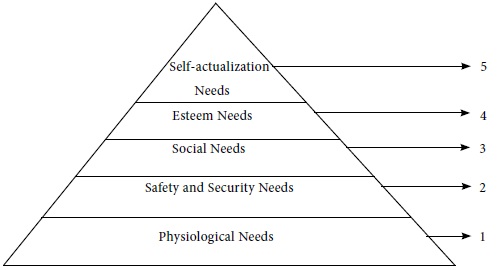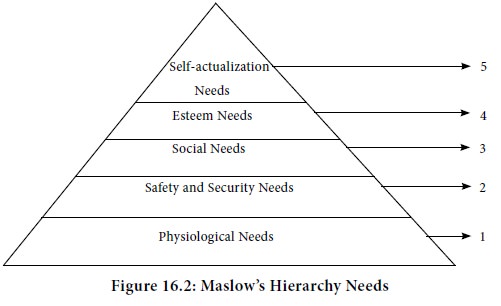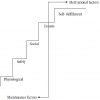Management Concepts & Organisational Behaviour - Motivation
Theories of Motivation
Posted On :

There are two types of motivational theories - content theories and process theories (cognitive theories).
Theories of Motivation
There are two types of motivational theories - content theories and process theories (cognitive theories). While content theories explain what motivates and what does not motivate, the process theories examine the variables that go into the motivational process taking place within an individual. Some of these theories are explained below.
Abraham Maslow has propounded this need hierarchy theory as early as in 1943. Maslow points out that human beings have divergent needs and they strive to fulfill those needs. The behaviour of an individual is determined by such needs. These needs range from biological needs at lower level to psychological needs at the highest level. Further, these needs arise in an order of hierarchy or priority such that lower level needs must be satisfied before higher level needs become important for motivation. Maslow postulates five basic needs arranged in an hierarchical fashion as follows:

There are two types of motivational theories - content theories and process theories (cognitive theories). While content theories explain what motivates and what does not motivate, the process theories examine the variables that go into the motivational process taking place within an individual. Some of these theories are explained below.
Maslow’s Need Hierarchy Theory
Abraham Maslow has propounded this need hierarchy theory as early as in 1943. Maslow points out that human beings have divergent needs and they strive to fulfill those needs. The behaviour of an individual is determined by such needs. These needs range from biological needs at lower level to psychological needs at the highest level. Further, these needs arise in an order of hierarchy or priority such that lower level needs must be satisfied before higher level needs become important for motivation. Maslow postulates five basic needs arranged in an hierarchical fashion as follows:

The first three levels of needs
at the bottom are known as lower order needs as they are related to one’s
existence and security. The top two levels of needs are called higher order
needs as they are concerned with personal development and realization of one’s
potential. The needs are explained below.
The physiological needs are the basic needs having the highest strength in terms of motivation. These are the needs arising out of biological tensions created as a result of deprivation of food, water, shelter, rest, etc. If these basic needs are gratified, then the next level needs become important and act as motivators.
Once the physiological needs are fulfilled, safety and security needs become predominant. These are the needs for self-preservation while physiological needs are for survival. These needs include security, stability, freedom from anxiety and a structured and ordered environment. Safety and security needs arise out of the concern for the fulfillment of physiological needs in the future. An individual seeks economic or social protection against future threats and dangers that he is exposed to. If once these needs are gratified, they fail to serve as motivators any more. The individual, then, moves on to the next level needs and strives for their fulfillment.
At the third level, social needs or love needs become important. An individual cannot live an isolated life. A sense of affiliation becomes important for a meaningful life. These needs include the need for love, affection, companionship and social interaction. We know very well that at home the child needs the love of parents and at school he needs the friendship of his classmates.
This is to attain recognition from others which would induce a feeling of self-worth and self-confidence in the individual. It is an urge for status, prestige and power. Self-respect is the internal recognition while respect from others is the external recognition. People who are able to fulfill this need feel that they are useful and have some positive influence on their surrounding environment.
At the highest level is the need to develop and realize one’s capacities and potentialities to the fullest extent possible. This need gets activated as motivator when all other needs have been reasonably fulfilled. At this level, the person wants to excel in the skills and abilities that he is endowed with. As a result, he seeks challenging work assignments that require creativity and talent. This need is inner-oriented and the motivation is intrinsic in nature. A self-actualizing person is creative, independent, content, and spontaneous and has a good perception of reality. He constantly endeavors to realize his full potential.
In conclusion, it may be said that Maslow’s model explains human behaviour in general. It has nothing to do with the employee motivation at the work place. Further, human needs may not necessarily have the hierarchy as shown by him. The relative dominance of not able to satisfy the social needs may prompt a person to set the physiological needs and safety needs aside and motivate him for earning the love and affection of the family members and the friendship of his colleagues.
Maslow felt that the human needs have a definite sequence of domination. Second need does not dominate until first need is reasonably satisfied and third does not dominate until first two needs have been reasonably satisfied and so on. The other side of the need hierarchy is that man is a wanting animal, he continues to want something or the other. He is never fully satisfied, the other need arises. As said above (according to Maslow), needs arise in a certain order of preference and not randomly. Thus, if one’s lower level needs (physiological and security needs) are unsatisfied, he can be motivated only by satisfying his lower level needs and not satisfying his higher level needs. Another point to note is that once a need or a certain order of needs is satisfied, it cases to be a motivating factor. Man lives for bread alone as long as it is not available. In the absence of air one can’t live, but there is it is plenty of air which ceases to be motivating.
The physiological and security needs are finite, but the needs of higher order are sufficiently infinite and are likely to be dominant in persons at higher levels in the organisation. This has been proved by various studies. A study by Boris Blai supported this by showing that managers and professionals in U.S.A. highly value self-realisation, while service and manual workers in India reported that they give to priority to job security, earnings and personal benefits all lower order needs.
The need priority model may not apply at all times in all places. Surveys in European countries and Japan have shown that the model does not apply very well to their managers. Their degree of satisfaction of needs does not vary according to the need priority model. For example, workers in Spain and Belgium felt that their esteem needs are better satisfied than their security and social needs. Apparently, cultural differences are an important cause of these differences. Thus, need hierarchy may not follow the sequence postulated by Maslow.
Another important proposition that one need is satisfied at one time is also a doubtful validity. Man’s behaviour at any time mostly guided by multiplicity of motives. However, one or two motives in any situation may be more dominant, while others may be of secondary importance.
There are always some people in whom, for instance, need for self-esteem seems to be more prominent than that of love. There are also creative people in whom the drive for creativeness seems to be more important. In certain people, the level of operation may be permanently
Physiological Needs
The physiological needs are the basic needs having the highest strength in terms of motivation. These are the needs arising out of biological tensions created as a result of deprivation of food, water, shelter, rest, etc. If these basic needs are gratified, then the next level needs become important and act as motivators.
Safety and Security Needs
Once the physiological needs are fulfilled, safety and security needs become predominant. These are the needs for self-preservation while physiological needs are for survival. These needs include security, stability, freedom from anxiety and a structured and ordered environment. Safety and security needs arise out of the concern for the fulfillment of physiological needs in the future. An individual seeks economic or social protection against future threats and dangers that he is exposed to. If once these needs are gratified, they fail to serve as motivators any more. The individual, then, moves on to the next level needs and strives for their fulfillment.
Social Needs
At the third level, social needs or love needs become important. An individual cannot live an isolated life. A sense of affiliation becomes important for a meaningful life. These needs include the need for love, affection, companionship and social interaction. We know very well that at home the child needs the love of parents and at school he needs the friendship of his classmates.
This is to attain recognition from others which would induce a feeling of self-worth and self-confidence in the individual. It is an urge for status, prestige and power. Self-respect is the internal recognition while respect from others is the external recognition. People who are able to fulfill this need feel that they are useful and have some positive influence on their surrounding environment.
Self-actualization Needs
At the highest level is the need to develop and realize one’s capacities and potentialities to the fullest extent possible. This need gets activated as motivator when all other needs have been reasonably fulfilled. At this level, the person wants to excel in the skills and abilities that he is endowed with. As a result, he seeks challenging work assignments that require creativity and talent. This need is inner-oriented and the motivation is intrinsic in nature. A self-actualizing person is creative, independent, content, and spontaneous and has a good perception of reality. He constantly endeavors to realize his full potential.
In conclusion, it may be said that Maslow’s model explains human behaviour in general. It has nothing to do with the employee motivation at the work place. Further, human needs may not necessarily have the hierarchy as shown by him. The relative dominance of not able to satisfy the social needs may prompt a person to set the physiological needs and safety needs aside and motivate him for earning the love and affection of the family members and the friendship of his colleagues.
Maslow felt that the human needs have a definite sequence of domination. Second need does not dominate until first need is reasonably satisfied and third does not dominate until first two needs have been reasonably satisfied and so on. The other side of the need hierarchy is that man is a wanting animal, he continues to want something or the other. He is never fully satisfied, the other need arises. As said above (according to Maslow), needs arise in a certain order of preference and not randomly. Thus, if one’s lower level needs (physiological and security needs) are unsatisfied, he can be motivated only by satisfying his lower level needs and not satisfying his higher level needs. Another point to note is that once a need or a certain order of needs is satisfied, it cases to be a motivating factor. Man lives for bread alone as long as it is not available. In the absence of air one can’t live, but there is it is plenty of air which ceases to be motivating.
The physiological and security needs are finite, but the needs of higher order are sufficiently infinite and are likely to be dominant in persons at higher levels in the organisation. This has been proved by various studies. A study by Boris Blai supported this by showing that managers and professionals in U.S.A. highly value self-realisation, while service and manual workers in India reported that they give to priority to job security, earnings and personal benefits all lower order needs.
Appraisal of Need Hierarchy Model
The need priority model may not apply at all times in all places. Surveys in European countries and Japan have shown that the model does not apply very well to their managers. Their degree of satisfaction of needs does not vary according to the need priority model. For example, workers in Spain and Belgium felt that their esteem needs are better satisfied than their security and social needs. Apparently, cultural differences are an important cause of these differences. Thus, need hierarchy may not follow the sequence postulated by Maslow.
Another important proposition that one need is satisfied at one time is also a doubtful validity. Man’s behaviour at any time mostly guided by multiplicity of motives. However, one or two motives in any situation may be more dominant, while others may be of secondary importance.
There are always some people in whom, for instance, need for self-esteem seems to be more prominent than that of love. There are also creative people in whom the drive for creativeness seems to be more important. In certain people, the level of operation may be permanently
Tags : Management Concepts & Organisational Behaviour - Motivation
Last 30 days 667 views














